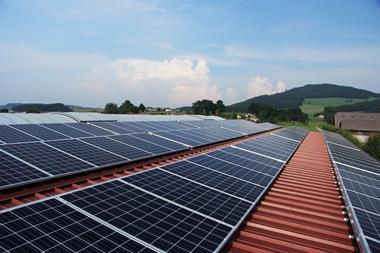Faced with finite fossil fuel sources and threats to the security of energy supplies, biofuels would appear to present an attractive and clean investment choice.
The term biofuels refers generally to fuels derived from biomass and so to vegetable oils, biodiesel and bioethanol.
Biodiesel is produced from rapeseed, sunflower seed, soybean, palm or frying oil and animal fats. Blended with petroleum, it creates a biodiesel blend for use in diesel engines that require little or no modification. Bioethanol is produced from maize in the US, sugar cane in Brazil or sugar beet and wheat in Europe for blending gasoline formulae.In Europe, demand and supply of biodiesel is much higher than for bioethanol, which dominates the US market; 80% biodiesel versus 20% bioethanol according to the European Bioethanol Fuels Association (eBio).
In addition to the Kyoto protocol, there are several other agreements, laws and fiscal incentives encouraging the use of cleaner fuels, which are predicted to be replaced by mandatory systems long term.
In March, the European Council of Ministers endorsed a minimum target of 10% biofuel use for petrol and diesel consumption in EU member states by 2020. This follows the EU’s 2003 biofuels directive that set reference values for the market share of biofuels - 2% by the end of 2005 and 5.75% to be achieved by the end of 2010 - which member states have had to incorporate into their national targets.
In the US, the 2005 Energy Policy Act requires the current amount of biofuel mixed with gasoline sold in the US to increase to 7.5bn gallons (28.4bn litres) by 2012, while the EU’s energy taxation directive, also in 2005, made it easier for member states to offer tax reductions on biofuels.
John Mullins, managing director at Bioverda, the bioenergy division of Ireland’s private sector developer NTR, believes that the biofuels sector provides a real investment opportunity to pension funds.
“In the past, the biofuels market was mainly occupied by private equity players aiming for a two- to three-year hit,” he says. “But the industry needs institutional investors used to long-term yields better than bonds and close to equity indexes. A 100m-gallon ethanol plant in the US, for example, will in equity terms require about $65-70m (€48-52m) in investment, while a 200,000 tonne biodiesel plant in Europe would probably require about €20-23m equity in total.”
eBio’s secretary-general Rob Vierhout says that institutional investors can invest in the growing market by investing in new or expanding plants or by buying shares. He suggests they invest in companies that have secured offtake contracts with oil companies and analyse the various biofuels for sustainability.
Anthony White, managing director of market development and head of advisory at UK investment banking group Climate Change Capital, sees investments going mainly into refineries. He says that the minimum amount of investment depends on the contract structure, the exposure and whether it is equity or debt. “If they invest in a refinery, for example, it’s important to differentiate between a biodiesel or bioethanol refinery because the capital cost requirements are relatively low for a biodiesel refinery but are higher for a bioethanol plant,” he explains. “However, the running costs are relatively low for a bioethanol plant but are higher for a biodiesel one. So there’s probably less debt involved in a bioethanol plant. But long-term contracts with biofuel buyers in continental Europe reduce the risk and consequently allow more debt, for example.”
Mullins says that typically project finance deals are being done on 2:1 debt equity ratios.
Donna Clarke, business development director at clean technology fund WHEB ventures, says that due to high vegetable oil and feedstock prices and lower gasoline prices, the sector does not appear very attractive to investors currently. But she believes that this may change once the policies and mandatory regimes take effect. She pegs investment returns at around 10-15% with potentially bigger returns from second-generation biofuels. Unlike the first generation, second-generation biofuels are not based on established technologies and conventional processes but are expected to be able to break down cellulose with the help of highly developed technology in a number of years.
The major risk of such investments is the underlying volatility because biofuels are based on soft commodities such as wheat and maize, which tend to follow energy. A hike in crop prices would, for example, reduce margins, while a slump in oil prices could steer people away from renewables altogether. However, White says that institutional investors are already used to the risk through investment in utilities or companies exposed to fossil fuel prices.
Simon Wilcox, CEO at UK bioethanol producer Green Spirit Fuels, expects that as in the US, ethanol and gasoline prices will become increasingly linked, as liquidity improves in Europe. He says the risk for pension funds also lies with the relatively new companies that produce biofuels.
Bill Page, vice president of State Street Global Advisors and head of its environmental, social and governance (ESG) team, thinks a basket approach is important to curb the volatility, in other words, a diversified portfolio built around biofuels through the purchase of several stocks but supplemented by the purchase of some larger names in the agricultural business that could win the end-game on ethanol through acquisition.
And Mullins rates investments in biogas as less risky than biofuels because power or gas purchase agreements are generally 15-year deals with indexation.
But despite the current momentum behind biofuels, concerns remain over the amount of biomass and land available for energy production and the energy-intensity and pollution of growing energy crops.
Wilcox says that based on statistics, converting grain to ethanol is more cost-effective than producing oil. He believes optimisation in farming will progressively reduce farming-related emissions, while growing plants absorb the carbon dioxide produced in burning fuels.
For bioethanol production, he says, there is no need to look far: “Brazil has pushed very hard on renewables and bioethanol, and there are concerns about how much more it can produce. But instead of increasing imports, we should focus on growing surplus crops in suitable areas without destroying the environment. We focus on wheat in the UK because we have a 3m tonnes surplus of it, which will produce enough ethanol to meet the 2010 requirement, in line with the UK’s renewable transport fuel obligation (RTFO). If 50% of the sidelined land were put back into production, it would produce another 2m tonnes. So to me the 2020 target of 10% is perfectly achievable with wheat. Above the 10%, using just wheat is not practical. But second-generation biofuels will help us to go that step.”
But Vierhout is sceptical. “Although the land and crop is available, we would need to have about 19bn litres of ethanol by 2020, and we are currently producing only 1.5bn litres,” he says.
While Wilcox still sees plenty of potential in increasing the yield in eastern European crops without hitting the food market, he predicts that biodiesel production will have to rely on imports to achieve the 2020 target due to the lack of sufficient rapeseed oil in Europe.
Mullins agrees: “We don’t have enough oil seed in Europe to meet the biodiesel demand, which is why we have imports. There are concerns about the sustainability of palm oil and a round table is trying to address that. But palm oil is not a natural biodiesel bedfellow. Rape oil and soy oil are much better sources of biodiesel.”
Mullins has doubts about Europe’s ability to meet the 2010 target but expects the 2020 target to be met with the help of second-generation biofuels like cellulosic ethanol. He points out that there are large tracks of Russia, Ukraine, Kazakhstan, Africa and central Asia that could grow crops but are untouched. These present an opportunity for developmental agri-investment funding for new crops like jatropha in Tanzania and Kenya. In the meantime, genetically modified crops and hybrids are constantly increasing yields.
White says: “The other question is whether we are moving to biofuels because of carbon or because of our worry about security of supply. Different governments state both reasons. For the US it seems to be much more about security of supply rather than emissions, whereas in Europe it’s a bit of both.”
Generally different fuels and crops and the way they are grown result in different carbon footprints. Ethanol from straw or wheat produces fewer emissions than ethanol from maize. And White says that bioethanol from sugar cane is about as good as you can get in terms of a very low footprint.
“Corn to ethanol reduces CO2 emissions by 80% after adjusting for the energy usage,” Mullins says. “But the bottom line is that politicians have signed up to biofuels as the way forward, which is the only thing that matters.”
The Massachusetts Institute of Technology (MIT) has found that the energy balance of converting maize into ethanol is easily influenced by different factors, but that when co-production credit is given - such as the energy saved by not additionally producing high-protein animal feed because it is a by-product of the maize-into-ethanol conversion - ethanol’s life-cycle energy use is lower than that of gasoline. MIT also found that producing ethanol from cellulose such as corn stover - the stalks that remain after maize has been harvested - and switchgrass - US prairie grass - has greater potential in reducing emissions; however, the technology is not economically viable yet.
ot everyone thinks that pension fund investments in the biofuels sector are a good idea. The director of investments at environmental financial adviser Impax, Peter Rossbach, says that it is very difficult for passive institutional investors to manage the risks and structure deals unless they match one of three criteria.
He says: “Investment in biofuels is only a good idea for institutional investors if they invest somewhere with cost advantages like Brazil. However, schemes involving cheap foreign fuel inputs are often problematic because of security of supply. The second possibility is a tolling agreement where the investor’s assets, cost-structure and revenue structure hedge each other in order to maintain margins. And third, biofuels investments may be rewarding when the investor buys at a deep discount. But all these are complicated bets and not easy for the institutional investor.”
And he warns: “Two banks we know in the US and Europe expect the greatest number of bank defaults in the project sector in the next 24 months. And the biofuels market has had almost no equity value in the past three months.”
Rossbach says the incentives created by governments would create more demand, encourage more plants and consequently drive up feedstock prices. He says that shares are prone to volatility due to the two commodities involved and companies present a solvency risk. He adds: “Institutional investors are usually only exposed to commodities that they can exit quickly because their instruments are liquid.”
So can biofuel investment be made more attractive?
Raffaello Garofalo, secretary general at the Brussels-based European Biodiesel Board (EBB), spoke out against the ranking of biofuels at the Argus Media biodiesel trading conference in March, as all generations of biofuels were needed.
He also attacked what he called “unfair” US B99.9 export subsidies, which he said, lead to blends with little biodiesel being shipped to Europe and sold below market price, thereby distorting the market.
However, Garofalo also claimed that biodiesel was not contributing to a reduction of the rain forest, pointing out that less than 3% of palm oil imported in the EU was used for biodiesel. He said the real culprit and motive behind the other 97% of EU palm oil imports was the food industry. He added that the EBB was proposing to set up simple and clear certification of sustainability to the raw material it employed, based on universal means of principles.
Explaining that the EU was currently revising its fuel quality directive, Garofalo adds: “As we need increased implementation it’s good to have longer-term targets. What we need is to increase the authorised blending of biodiesel in mineral diesel from 5% to 10%. This ceiling needs to be lifted very quickly.”
And Wilcox says: “Motor manufacturers say that normal vehicles can cope with 10% of bioethanol and for any more, cars would need to be modified - although legislation doesn’t allow us to use 10% yet, only 5%. However, Europe is now pushing to change this.”












No comments yet